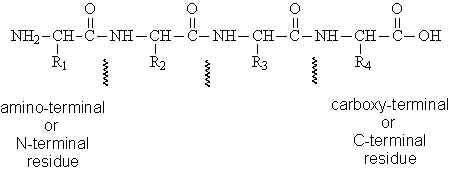![]() Introduction
to Protein Structure
Introduction
to Protein Structure
Peptides
Peptides (and proteins) are made by joining amino acids together via amide bonds.
Amides are made by condensing together a carboxylic acid and an amine:

Any number of amino acids can be joined together to form peptides of any length.
Small peptides (containing less than a couple of dozen amino acids) are sometimes called oligopeptides. Longer peptides are many times called polypeptides.
Notice that peptides have a "polarity"; each peptide has only one free a-amino group (on the amino-terminal residue) and one free (non-sidechain) carboxyl group (on the carboxy-terminal residue):
 |
|
A Tetrapeptide |
When thinking about peptide (and protein) structure, it is often times useful to distingush between the peptide "backbone" and the sidechains. The backbone atoms consist of the peptide amide units and the alpha carbons; the sidechains consists of the remaining atoms in the molecule (i..e the "R" groups of each amino acid):
 |
Copyright © 1998, 1999, 2007 by Frank R. Gorga; Page maintained by F.R. Gorga; Last updated: 12-Mar-2007